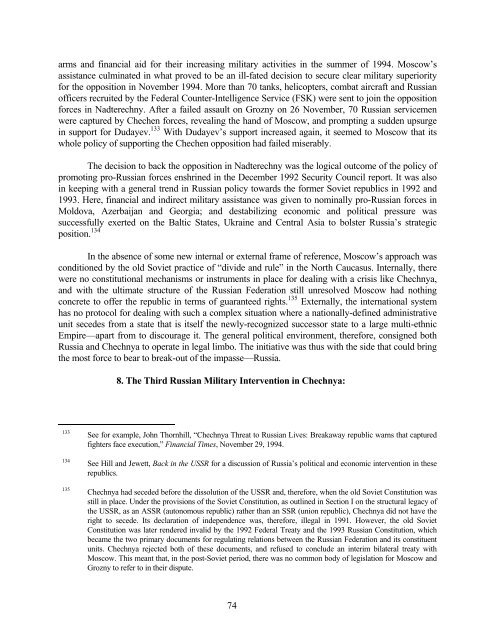RUSSIA'S TINDERBOX - Belfer Center for Science and International ...
RUSSIA'S TINDERBOX - Belfer Center for Science and International ...
RUSSIA'S TINDERBOX - Belfer Center for Science and International ...
Create successful ePaper yourself
Turn your PDF publications into a flip-book with our unique Google optimized e-Paper software.
arms <strong>and</strong> financial aid <strong>for</strong> their increasing military activities in the summer of 1994. Moscow’s<br />
assistance culminated in what proved to be an ill-fated decision to secure clear military superiority<br />
<strong>for</strong> the opposition in November 1994. More than 70 tanks, helicopters, combat aircraft <strong>and</strong> Russian<br />
officers recruited by the Federal Counter-Intelligence Service (FSK) were sent to join the opposition<br />
<strong>for</strong>ces in Nadterechny. After a failed assault on Grozny on 26 November, 70 Russian servicemen<br />
were captured by Chechen <strong>for</strong>ces, revealing the h<strong>and</strong> of Moscow, <strong>and</strong> prompting a sudden upsurge<br />
in support <strong>for</strong> Dudayev. 133 With Dudayev’s support increased again, it seemed to Moscow that its<br />
whole policy of supporting the Chechen opposition had failed miserably.<br />
The decision to back the opposition in Nadterechny was the logical outcome of the policy of<br />
promoting pro-Russian <strong>for</strong>ces enshrined in the December 1992 Security Council report. It was also<br />
in keeping with a general trend in Russian policy towards the <strong>for</strong>mer Soviet republics in 1992 <strong>and</strong><br />
1993. Here, financial <strong>and</strong> indirect military assistance was given to nominally pro-Russian <strong>for</strong>ces in<br />
Moldova, Azerbaijan <strong>and</strong> Georgia; <strong>and</strong> destabilizing economic <strong>and</strong> political pressure was<br />
successfully exerted on the Baltic States, Ukraine <strong>and</strong> Central Asia to bolster Russia’s strategic<br />
position. 134<br />
In the absence of some new internal or external frame of reference, Moscow’s approach was<br />
conditioned by the old Soviet practice of “divide <strong>and</strong> rule” in the North Caucasus. Internally, there<br />
were no constitutional mechanisms or instruments in place <strong>for</strong> dealing with a crisis like Chechnya,<br />
<strong>and</strong> with the ultimate structure of the Russian Federation still unresolved Moscow had nothing<br />
concrete to offer the republic in terms of guaranteed rights. 135 Externally, the international system<br />
has no protocol <strong>for</strong> dealing with such a complex situation where a nationally-defined administrative<br />
unit secedes from a state that is itself the newly-recognized successor state to a large multi-ethnic<br />
Empire—apart from to discourage it. The general political environment, there<strong>for</strong>e, consigned both<br />
Russia <strong>and</strong> Chechnya to operate in legal limbo. The initiative was thus with the side that could bring<br />
the most <strong>for</strong>ce to bear to break-out of the impasse—Russia.<br />
8. The Third Russian Military Intervention in Chechnya:<br />
133 See <strong>for</strong> example, John Thornhill, “Chechnya Threat to Russian Lives: Breakaway republic warns that captured<br />
fighters face execution,” Financial Times, November 29, 1994.<br />
134 See Hill <strong>and</strong> Jewett, Back in the USSR <strong>for</strong> a discussion of Russia’s political <strong>and</strong> economic intervention in these<br />
republics.<br />
135 Chechnya had seceded be<strong>for</strong>e the dissolution of the USSR <strong>and</strong>, there<strong>for</strong>e, when the old Soviet Constitution was<br />
still in place. Under the provisions of the Soviet Constitution, as outlined in Section I on the structural legacy of<br />
the USSR, as an ASSR (autonomous republic) rather than an SSR (union republic), Chechnya did not have the<br />
right to secede. Its declaration of independence was, there<strong>for</strong>e, illegal in 1991. However, the old Soviet<br />
Constitution was later rendered invalid by the 1992 Federal Treaty <strong>and</strong> the 1993 Russian Constitution, which<br />
became the two primary documents <strong>for</strong> regulating relations between the Russian Federation <strong>and</strong> its constituent<br />
units. Chechnya rejected both of these documents, <strong>and</strong> refused to conclude an interim bilateral treaty with<br />
Moscow. This meant that, in the post-Soviet period, there was no common body of legislation <strong>for</strong> Moscow <strong>and</strong><br />
Grozny to refer to in their dispute.<br />
74
















